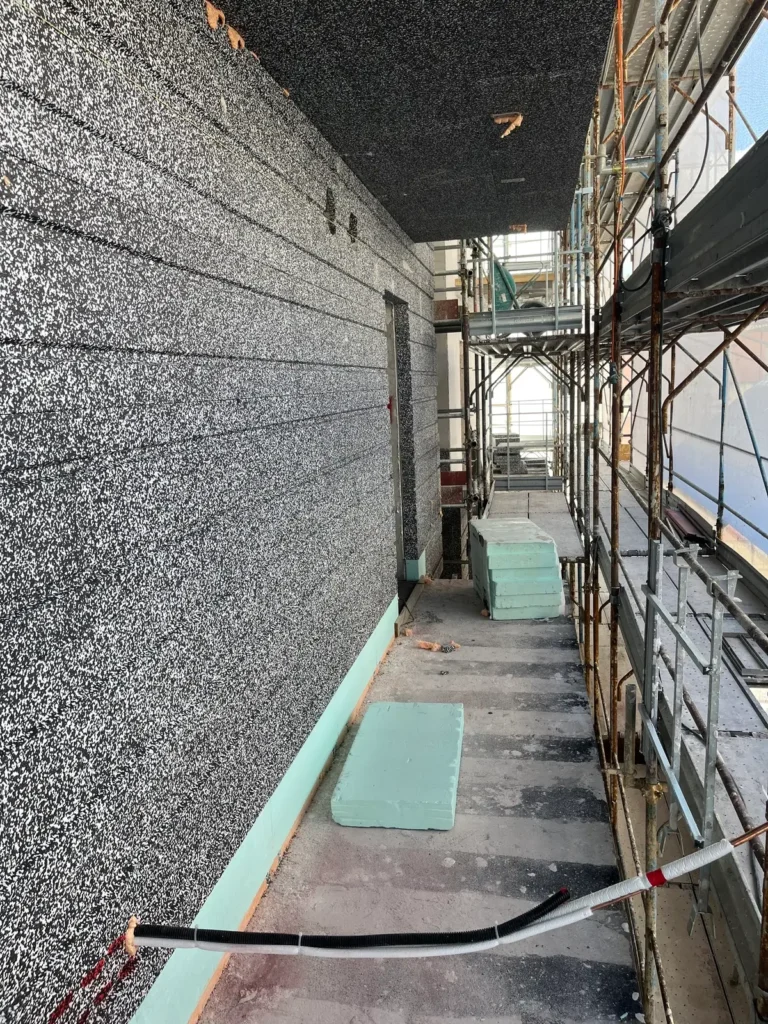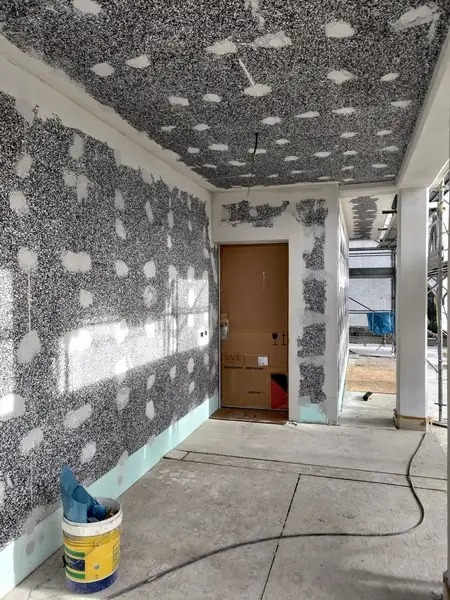Thermal insulation coating systems and energy upgrading of buildings
Innovation for energy efficiency
Energy upgrading of buildings refers to a set of interventions that aim to improve the energy performance of a building, reducing energy consumption and greenhouse gas emissions.
Building envelope thermal insulation
Implementation of Thermal Coat System in compliance with CAM (Minimum Environmental Criteria) requirements in new buildings or existing buildings, designed by experienced thermal coat technicians. The company addresses qualified suppliers to purchase materials with European Technical Assessment (ETA) certificate and CE marking and its own specialized installers, whose knowledge, skills and competences are certified according to UNI 11716:2018, specific for professionals performing the installation of Professionals performing installation of external insulation and Finishing System (EIFS).
The importance of the certification
Until 2018, Exterior Thermal Insulation Application Manual (Manuale Cappotto Termico Cortexa), developed on the basis of European guidelines, was the only point of reference for the correct design and subsequent installation of thermal insulation. In June 2018, UNI 11716:2018 “Unregulated professional activities – Professionals performing installation of External Insulation and Finishing System (EIFS) – Knowledge, skill and competence requirements” was published for the specific training of installers. The path leading to the professional qualification of those working in the field of energy efficiency in buildings involves attending a training course and passing the certification exam.
What is a Thermal Coat System?

Thermal insulation is a state-of-the-art system in terms of efficiency, healthiness and sustainability in living. Whether in new construction or renovation, it creates a continuous barrier around the building that can eliminate thermal bridging and significantly reduce heat loss. A Thermal Coat System consists of a combination of adhesive and mechanical fixings attached to the insulating panel (made of sintered expanded polystyrene, mineral wool, expanded polyurethane, wood fiber…), which is then covered with a reinforced skim coating to protect the surface and finally decorated.
Energy upgrading also provides important long-term economic benefits. By reducing energy consumption, buildings become cheaper to run, with a significant reduction in utility expenses. This not only results in immediate savings for owners or occupants, but also increases the value of the property on the market. Energy-efficient buildings are indeed increasingly sought after, both in the residential and commercial markets. In addition, energy upgrading helps reduce the environmental impact of buildings, an increasingly important aspect in a world that is moving toward greater ecological awareness. By reducing greenhouse gas emissions and improving energy efficiency, upgraded buildings play a key role in combating climate change and promoting sustainable urban development.
Energy renovation of buildings

Energy renovation of buildings is a complex, multidimensional process aimed at improving the energy efficiency and comfort of a building through a series of targeted interventions. This process begins with a detailed analysis of the building, assessing aspects such as existing insulation, heating and cooling system, efficiency of fixtures, and solar exposure. Based on these parameters, specific interventions are proposed, which can range from small modifications, such as crack sealing, to large renovation projects, such as the installation of high-efficiency heating and cooling systems. Each intervention is designed not only to reduce energy consumption, but also to improve the overall comfort of occupants by regulating indoor temperature, humidity, and air quality. Energy upgrading is thus an essential strategy for adapting buildings to the challenges of the future, combining sustainability, energy savings, and improved living comfort.
Insulation and energy upgrading: a winning combination
When insulation is combined with other interventions, such as high efficiency replacement windows or the installation of more modern, energy-efficient heating and cooling systems, the results are impressive. In fact, the new systems do not have to work hard to compensate for thermal losses, which results in reduced energy consumption and a longer lifespan of the systems.
In addition, this combination of interventions promotes a healthier and more comfortable indoor environment. With better temperature regulation and effective insulation, problems such as mold and dampness, which are often the result of poor insulation and temperature changes, are dramatically reduced.
From an economic point of view, investing in insulation and energy upgrading pays off in the long run. Although the initial investment may seem considerable, the savings on energy bills soon become obvious. This type of intervention also increases the value of the property, making it more attractive on the real estate market, especially in an era when energy efficiency is increasingly valued.
Finally, we must consider the important environmental impact. By reducing energy consumption, we decrease greenhouse gas emissions. This is especially relevant in a global context where reducing the carbon footprint has become a priority. Adopting measures such as insulation and energy retrofitting technologies therefore aligns with the goals of sustainable development and fighting against climate change.
Energy efficiency and seismic resilience
SDF VERNICIATURE performs energy efficiency and seismic strengthening interventions on single-family, multi-family and flat complexes eligible for building bonuses and on buildings renovated or reconstructed following earthquake events. Under the new Italian measure, Superbonus 110%, SDF VERNICIATURE has carried out integrated seismic and energy retrofitting interventions. Energy upgrades include thermal insulation, modernization of heating and cooling systems, and other measures to optimize energy efficiency. Seismic resistance has been achieved through structural anti-seismic reinforcements and protections of frames and filling.
110% Superbonus
The Government intended to invest in the revitalization of the construction sector and the promoting urban upgrading projects through anti-seismic interventions and energy-efficient technologies, with tax incentives introduced by Law 77/2020 “SUPERBONUS 110%”, for energy efficiency or seismic strengthening interventions.
Frequently Asked Questions
-
How much can external insulation save on your energy bill?
Thermal insulation coating is extremely effective in reducing energy costs, with potential savings ranging from 20 percent to 40 percent, depending on the specific features of the building and the local climate. Insulation in your home provides resistance to heat flow and lowers your heating and cooling costs. -
Are home energy upgrades worth the investment?
Definitely. Investing in energy upgrades not only improves energy efficiency and reduces building operating costs, but also increases its market value. Upgraded buildings often meet higher energy standards, making them more attractive to environmentally conscious buyers and tenants. In addition, benefits from tax incentives and government subsidies in many regions further increase their investment value. -
How long does it take to install external wall insulation?
The time required to install insulation can vary depending on the size and specifics of the building. For an average-sized building, installation can take from a few weeks to a month. However, careful planning can help to minimize the disruptions caused by unforeseen events. -
Does insulation also help with noise?
Yes. One of the additional benefits of insulation is improved soundproofing. The insulation layer applied to exterior walls can significantly reduce noise from outside, creating a quieter and more comfortable indoor environment. -
How do you determine the type of interventions needed for energy upgrades?
Determining the interventions needed for energy upgrades begins with a detailed energy audit. This assessment includes analyzing the building’s current energy performance, identifying areas for improvement, and defining solutions suited to the building’s specific needs. Based on this data, a tailored upgrading plan is developed and this may include thermal insulation, heating and cooling system upgrade and other measures to optimize energy efficiency.